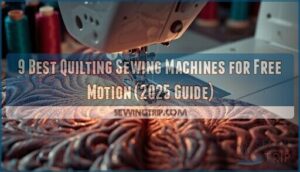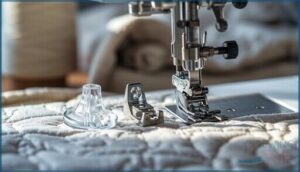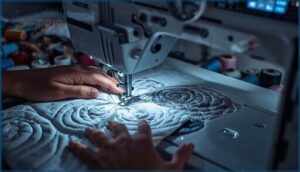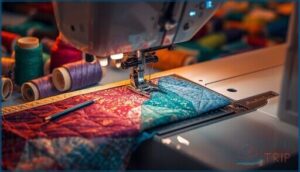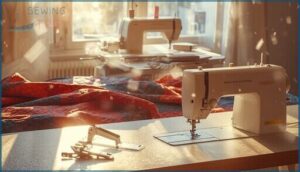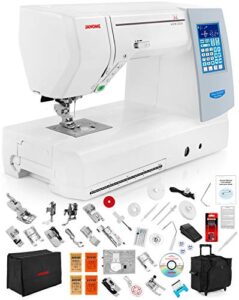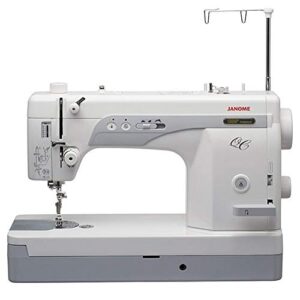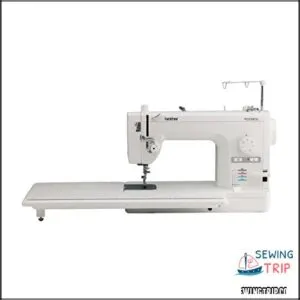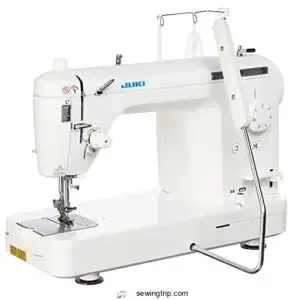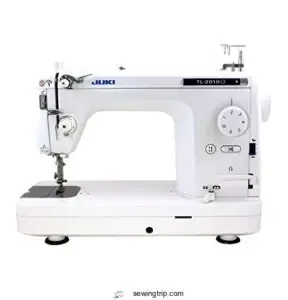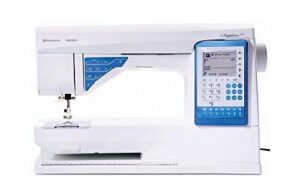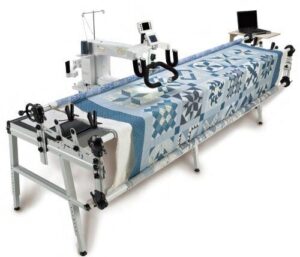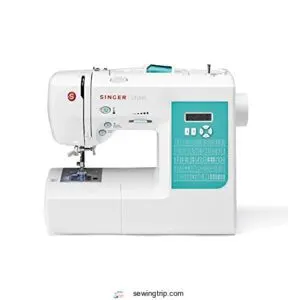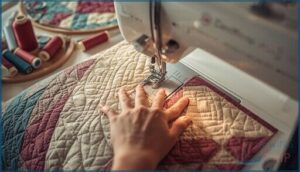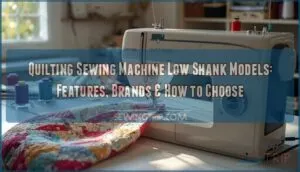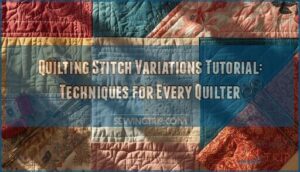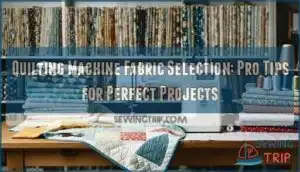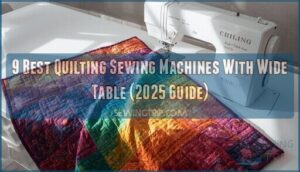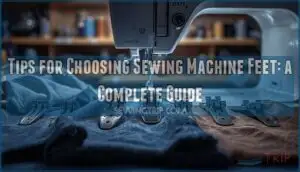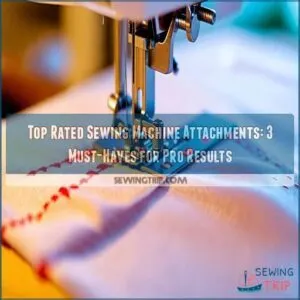This site is supported by our readers. We may earn a commission, at no cost to you, if you purchase through links.
Free motion quilting feels like flying—your hands guide the fabric, your machine follows, and suddenly those intricate swirls and feathers aren’t just for professional quilters anymore. But here’s what nobody tells you upfront: your regular sewing machine might be holding you back, not because it lacks power, but because it’s designed to control fabric movement when free motion demands exactly the opposite.
The right quilting sewing machine for free motion work changes everything—drop those feed dogs, adjust your speed with precision, and watch your stitches flow smoothly across quilt sandwiches that would make lesser machines protest.
Whether you’re ready to graduate from walking-foot quilting or you’re eyeing king-size projects that need serious throat space, understanding which features actually matter will save you from expensive buyer’s remorse and hours of wrestling with the wrong equipment.
Table Of Contents
- Key Takeaways
- Key Features for Free Motion Quilting Machines
- Top 9 Quilting Sewing Machines for Free Motion
- 1. Janome Computerized Sewing Machine
- 2. Janome Quilting Sewing Machine Bundle
- 3. Janome High Speed Sewing Machine
- 4. Brother High Speed Sewing Machine
- 5. Juki Straight Stitch Sewing Machine
- 6. Juki TL-2010Q Sewing Quilting Machine
- 7. Husqvarna Viking Sapphire Sewing Machine
- 8. Majestic Quilting Frame System
- 9. Singer Fashion Mate Sewing Quilting Machine
- Comparing Quilting Vs. Regular Sewing Machines
- How to Choose The Best Free Motion Quilting Machine
- Essential Accessories and Tips for Free Motion Quilting
- Frequently Asked Questions (FAQs)
- Conclusion
Key Takeaways
- Free motion quilting demands specific machine features like drop feed dogs, adjustable speed control, and adequate throat space (9-12 inches for most projects, 12+ for king-size quilts) to give you the control and workspace necessary for creating intricate designs.
- The right machine transforms your quilting experience through features like stitch regulators that automatically adjust motor power for consistent stitches, extension tables that eliminate fabric drag, and specialty feet that enable unrestricted movement in any direction.
- Top performers range from budget-friendly options like the Singer Fashion Mate ($199.99) for beginners to high-speed workhorses like the Brother PQ1500SL (1,500 SPM) and Janome 1600P-QC, with mid-range computerized models offering the best balance of features and value.
- Essential accessories—including extension tables, free motion quilting feet, and proper lighting—combined with regular maintenance like clearing lint after every project and changing needles every 8-12 hours, protect your investment and ensure smooth, consistent stitching.
Key Features for Free Motion Quilting Machines
Free motion quilting isn’t just about having any sewing machine—it’s about finding one that actually gives you the control and workspace you need to move freely. The right features can make the difference between fighting your machine and feeling like you’re dancing with fabric.
Let’s break down the must-haves that separate a true free motion machine from one that’ll just frustrate you.
Drop Feed Dogs and Feed Dog Adjustment
Freedom starts when you drop those feed dogs—the teeth that normally push fabric forward. In free motion quilting, lowering or covering the feed dogs hands full control back to you, letting you move the quilt sandwich in any direction instead of the machine’s standard 2–4 mm advance.
Modern quilting machines include a lever or button for this, while some older models need a darning plate to block the teeth and release true creative movement.
Understanding the role of feed dog settings is vital for mastering free motion quilting techniques.
Free Motion and Darning Foot Compatibility
Once you’ve dropped the feed dogs, the right free motion foot becomes your next ally. Most quilting machines use low shank feet—about 19 mm from screw hole to base—which fits more than 80% of domestic models like Brother, Singer, and Janome.
Check your shank type before buying, because high shank and slant shank feet won’t fit, and proper needle clearance matters when handling different quilt thicknesses.
To achieve best results, understanding free motion quilting is essential for selecting the right foot.
Speed Control and Stitch Regulation
Speed consistency transforms your Free Motion Quilting from shaky experiment to confident artistry. Stitch regulators sense fabric movement and automatically adjust motor power, delivering uniform stitches whether you’re crawling through tight spirals or racing across open space. Look for machines with adjustable sensitivity—this fine-tunes stitch length to match your hand speed, letting you focus on design instead of fighting the pedal.
Stitch regulators transform free motion quilting by automatically adjusting motor power to deliver uniform stitches regardless of your hand speed
- Stitch regulators maintain 12 stitches per inch regardless of your quilting pace
- Variable speed control sets maximum machine speed for intricate Free Motion Quilting Techniques
- High-powered motors reach 1,800 stitches per minute for efficiency on larger quilts
Throat Space and Extension Table Options
Throat space is a critical factor in determining how much quilt you can manage on your machine without resorting to complex maneuvers. Domestic quilting machines typically offer 7 to 9 inches of throat space between the needle and the column, which is sufficient for smaller projects like table runners and baby quilts. For those aiming to quilt king-size projects, a machine with a 12-inch throat space is ideal, as it allows you to handle twin-size quilts in a single session.
| Throat Space | Best For |
|---|---|
| 6–8 inches | Small projects, table runners |
| 9–12 inches | Throw quilts, lap quilts |
| 12+ inches | Twin quilts, larger bed quilts |
| 16–19 inches | Long-arm systems, production work |
Extension tables are a game-changer for quilters, transforming the limited sewing machine bed into a more spacious 18-by-24-inch work area. These tables often feature custom-cut acrylic surfaces that eliminate gaps where batting can snag, and printed rulers help keep quilt blocks perfectly aligned. The continuous, level surface around the needle significantly reduces fabric drag, minimizing skipped stitches and alleviating shoulder strain during extended Free Motion Quilting sessions.
Built-in Stitches and Automatic Needle Threader
When you’re pushing creative boundaries with free motion quilting, stitch variety, impact, and threader usability can make or break your flow. Modern sewing machines with built-in stitch features offer 20 to 50 options—from straight stitch to specialty stippling—that directly improve quilting quality.
Here’s what efficiency benefits look like:
- Automatic needle threader cuts setup time and eye strain in half
- Stitch length adjustments between 1.5mm and 3.5mm balance precision with speed
- Programmable patterns let you save custom free motion quilting designs
- Blanket and darning stitches add texture without sacrificing durability
- Digital interfaces simplify stitch selection mid-project
These feature trends reflect what quilters actually demand: fewer interruptions, more creative control.
Price Considerations and Value-Added Features
Your budget shapes every decision, from entry-level free motion quilting machines around $250–$600 to premium systems nearing $6,000. Stitch regulation cost adds thousands but delivers consistent stitch length—Baby Lock Anthem bundles it with $699 in accessories.
Workspace value shows up in extension tables and 10″+ throat space, while accessory bundles (walking feet, darning feet) justify higher prices.
Brand positioning and long-term value separate hobbyist picks from professional-grade affordable sewing machines.
Top 9 Quilting Sewing Machines for Free Motion
You’ve learned what makes a machine ready for free motion work, so now it’s time to meet the top performers that deliver on those features.
The machines below represent a range of throat spaces, speeds, and price points, each proven to handle the demands of free motion quilting.
Whether you’re working on bed-sized quilts or smaller projects, you’ll find a machine here that fits your budget and creative ambitions.
1. Janome Computerized Sewing Machine
You won’t find a more balanced blend of precision and versatility than Janome’s computerized sewing machines for Free Motion Quilting. Models like the Janome 3160QDC and Janome MC6650 deliver serious stitch regulation alongside feed adjustment features that let you drop those feed dogs instantly.
With 30-plus built-in stitches, automatic needle threaders, and foot compatibility for darning attachments, these machines handle intricate FMQ work beautifully.
Extension tables expand your workspace, while value features like LCD displays and 9mm stitch width give you creative control without breaking the bank.
Best For: Quilters who want precise stitch control and the flexibility to tackle both intricate free motion work and everyday sewing projects without constantly switching machines.
- Drop feed dogs and adjustable presser foot pressure give you total control for smooth free motion quilting, especially on models like the 1600P that handle speeds up to 1600 stitches per minute.
- Extension tables (up to 24″ x 15″) and generous throat space mean you can actually maneuver large quilts without fighting fabric bunching or limited workspace.
- Built-in features like automatic needle threaders, LCD displays, and 200 stitches (depending on model) make these machines versatile enough for garment sewing, home decor, and detailed quilting work.
- Some users report durability issues and frustrating customer support experiences, particularly with error codes and foot controller problems on higher-end models.
- The learning curve can be steep if you’re new to computerized machines—getting comfortable with all the advanced features and accessories takes time and patience.
- Prices vary wildly from around $400 to over $1000, and the limited 2-year electronics warranty might feel short for a significant investment.
2. Janome Quilting Sewing Machine Bundle
When you grab a Janome 3160QDC-G or 4120QDC-G quilting bundle, you’re breaking free from piecemeal purchases—extension tables, specialty quilting feet, and hard covers arrive ready to roll.
These lightweight machines (12–14 pounds) pack 60 built-in stitches, drop-feed capability for free-motion work, and speed sliders that tame your foot pedal during intricate stippling.
Bundle value shines through included darning feet and walking feet, while portability means guild meetings and retreats won’t slow you down.
Ergonomics matter: extra-high presser lifts handle thick quilt sandwiches, and LCD screens keep stitch selection straightforward.
Best For: Quilters who want a complete, portable setup with free-motion capability and specialty feet included, without hunting down accessories separately.
- Complete bundle saves money and hassle by including extension tables, walking feet, darning feet, and hard covers right out of the box
- Lightweight design (12–14 pounds) makes it easy to take to classes, guild meetings, or quilting retreats without straining your back
- Drop-feed system and speed control slider give you precise command over free-motion quilting, from stippling to thread painting
- The 60 stitches and multiple attachments create a learning curve that takes practice to master fully
- Reverse button placement may feel awkward depending on your natural hand positioning while sewing
- Mid-range pricing means you’re paying more upfront than basic machines, even with the bundled accessories
3. Janome High Speed Sewing Machine
If you’re ready to leave pedestrian stitching speeds behind, Janome’s 1600P-QC and HD9 Professional deliver 1,600 stitches per minute—a straight-stitch powerhouse built for quilters who refuse to wait.
These highspeed sewing machines feature nearly 9 x 6-inch throat space, six ultra-bright LEDs, and side-loading jumbo bobbins that cut thread changes on sprawling quilts.
Pair them with a Janome Convertible Free Motion foot and a 27 x 13.5-inch extension table, and you’ve got workspace ergonomics that rival dedicated long-arms—without the price tag or footprint.
Best For: Serious quilters and sewists who need industrial-speed straight stitching for large projects but don’t have the budget or space for a dedicated long-arm machine.
- Blazing 1,600 stitches per minute lets you finish quilts in a fraction of the time without sacrificing stitch quality
- Nearly 9-inch throat space and compatibility with large extension tables give you room to maneuver king-size quilts
- Heavy-duty build with eight ball bearings and side-loading jumbo bobbin means fewer thread changes and smooth operation even through thick layers
- Straight-stitch only—no zigzag or decorative stitches if you need versatility beyond quilting and piecing
- Heavy at 38.6 pounds, so moving it between workspaces or taking it to classes isn’t easy
- Out of production, which could make finding parts or service trickier down the road
4. Brother High Speed Sewing Machine
Brother’s PQ1500SL straight-stitch machine hits 1,500 stitches per minute, letting you blaze through king-size quilts without sacrificing control—its four feed-dog settings plus pin feed system handle slippery silk or thick denim with equal confidence.
With workspace ergonomics that extend to 11 by 23.2 inches on the included table and a knee lifter freeing both hands for fabric maneuvering, you get long-arm functionality at a fraction of the cost.
Dealers often slash prices to $300–$400 during promotions, making this high-speed quilting workhorse an unbeatable value proposition for free motion artists.
Best For: Experienced quilters who need a high-speed workhorse for large projects and free motion quilting without the cost or footprint of a long-arm system.
- Blazing 1,500 stitches per minute lets you finish king-size quilts in a fraction of the time compared to standard machines.
- Extended 11 by 23.2-inch workspace with knee lifter gives you the control and fabric support of a long-arm setup at a fraction of the price.
- Four feed-dog settings plus pin feed system handle everything from slippery silks to thick denim with consistent precision.
- Threading mechanism and needle threader can be finicky, especially with cheaper thread brands.
- Side-loading bobbin case doesn’t alert you when thread runs out, which can interrupt your flow mid-project.
- Not beginner-friendly—the machine’s speed and straight-stitch-only design assume you already know your way around a sewing machine.
5. Juki Straight Stitch Sewing Machine
Juki’s TL-2010Q straight stitch machine delivers industrial-grade stitch quality at up to 1,500 stitches per minute, with speed control that lets you dial down to 200 when precision matters more than pace. Drop feed dogs via a simple switch enable free motion quilting, while the aluminum die-cast frame keeps vibration minimal even when you’re pushing the pedal.
Though sales dipped 27% mid-2025—likely from a lack of beginner tutorials—quilters praise its sharp stitches and durable build, making it ideal for tackling multiple denim layers or king-size quilts with consistent, regulated results.
Best For: Quilters and sewers who need industrial-quality straight stitching for thick fabrics, free motion quilting, and large projects like king-size quilts or heavy-duty garments.
- Adjustable speed from 200 to 1,500 stitches per minute gives you control for detailed work or fast production
- Drop feed dog system and wide throat space make free motion quilting and maneuvering large projects easier
- Durable aluminum die-cast construction minimizes vibration and delivers sharp, consistent stitches through multiple thick layers
- Straight stitch only—no zigzag or decorative stitches, so it’s not versatile for all sewing types
- At 25.4 pounds, it’s heavy enough that moving it around requires some effort
- Some users report the automatic needle threader can be finicky and may not work reliably
6. Juki TL-2010Q Sewing Quilting Machine
What sets the Juki TL-2010Q apart is its knee lifter, offering hands-free presser foot control to maintain momentum during complex free-motion quilting sessions. The 8½-by-6-inch throat space provides ample room for bulky layers, while the automatic thread trimmer cuts both needle and bobbin threads with one tap, saving valuable time on long projects.
Priced around $1,199, this straight-stitch powerhouse handles thick quilt sandwiches without bunching, making it an ideal choice for quilters seeking speed and performance without the full long-arm investment.
Best For: Serious quilters and sewists who need speed, precision, and hands-free control for tackling large projects and thick fabric layers without investing in a full long-arm machine.
- Knee lifter and automatic thread trimmer keep your hands free and workflow fast, especially during intricate free-motion quilting.
- Generous 8½-by-6-inch throat space handles bulky quilts and multi-layer projects with consistent stitch quality.
- Adjustable speed control (200–1,500 stitches per minute) lets you go slow for detail work or crank it up for long seams.
- Straight stitch only—no zigzag or decorative stitches, so it’s limited to piecing and quilting tasks.
- Light may not be bright enough for detailed work, possibly requiring an external lamp.
- Thread cutting mechanism can need firm foot pedal pressure, which takes some getting used to.
7. Husqvarna Viking Sapphire Sewing Machine
For quilters craving the full digital experience, the Husqvarna Viking Sapphire 930 delivers two dedicated free motion modes that adjust stitch formation when you drop those feed dogs. You’ll work with a generous 10-inch throat space—enough to pivot lap and twin quilts without cramping your style—plus five electronic speed settings that cap maximum stitching speed for smooth, consistent stitch length.
Its Sensor System Technology automatically tweaks presser foot pressure as you cross seams, keeping everything balanced when you’re layering thick batting. Expect to invest in the mid-range category for this computerized quilting machine’s performance.
Best For: Quilters who want computerized precision and a roomy 10-inch workspace for free motion quilting without stepping up to industrial territory.
- Two dedicated free motion modes automatically optimize stitch settings when you drop the feed dogs, taking the guesswork out of stippling and freeform designs.
- Sensor System Technology adjusts presser foot pressure on the fly, so you get even feeding across seams and thick batting layers without manual tweaking.
- Five electronic speed settings let you cap your max stitching speed, making it easier to maintain consistent stitch length during free motion work.
- The needle threader can be finicky and doesn’t always line up properly, which gets frustrating when you’re switching thread colors frequently.
- Automatic tension struggles with multiple fabric layers despite the sensor tech, so you might need to override it on bulkier quilt sandwiches.
- The thread cutter is prone to breaking or tangling thread, which interrupts your flow between quilting segments.
8. Majestic Quilting Frame System
While most quilters shop for machines, seasoned rebels know a rock-solid frame transforms everything. The Majestic Quilting Frame System gives you a five- or ten-foot rail setup built from heavy-duty steel—perfect for wrestling king-size quilts without the usual bunching drama.
Its dual-track design cuts drag so you can glide through free motion quilting passes smoothly, and adjustable height means you’ll dial in ergonomic comfort fast.
Expect premium pricing above $1,000, but the build quality and frame compatibility with most domestic and long-arm machines justify that investment.
Best For: Serious quilters and professionals who need a stable, premium-quality frame to handle large projects from crib to king size with smooth, consistent stitching.
- Heavy-duty steel and aluminum construction with dual-track rails delivers exceptional stability and smooth gliding motion for precision work
- Adjustable height and leveling legs let you customize ergonomics and adapt to uneven floors or different machine sizes
- Disassembles for storage or transport, making it practical even if you don’t have a dedicated quilting studio
- Premium pricing above $1,000 puts it out of reach for casual quilters or beginners on a budget
- Assembly takes 1-2 hours and requires two people for the king size, so setup isn’t quick or solo-friendly
- King size demands roughly 7 by 11 feet of floor space, which won’t work in smaller rooms or apartments
9. Singer Fashion Mate Sewing Quilting Machine
If you’re on a budget but want to break into free motion quilting, the Singer Fashion Mate delivers a surprising value proposition. Its 32 built-in stitches and adjustable stitch customization (up to 6mm width, 4mm length) let beginners experiment freely, while the heavy-duty metal frame earns solid durability reviews.
Portability perks shine with its 14-pound weight, and beginner friendliness is clear through the one-step buttonhole and built-in needle threader.
Add a low-shank free motion foot, drop those feed dogs, and you’ve got an accessible sewing machine ready for quilting adventures.
Best For: Beginners and budget-conscious sewists who want to explore free motion quilting without investing in expensive equipment.
- Heavy-duty metal frame provides excellent stability and durability despite the affordable $199.99 price point.
- Lightweight at 14 pounds with 32 built-in stitches, making it both portable and versatile for various projects.
- Beginner-friendly features like the automatic needle threader, one-step buttonhole, and top drop-in bobbin system simplify the learning curve.
- Reverse stitch button can be slow and inconvenient during regular sewing tasks.
- Bobbin thread tends to jam underneath the plate, requiring occasional troubleshooting.
- Not suitable for heavy-duty projects or large-scale sewing work due to its lighter-duty construction.
Comparing Quilting Vs. Regular Sewing Machines
If you’ve been sewing garments and suddenly feel ready to tackle a quilt, you might wonder whether your trusty machine can handle the shift. Quilting machines and regular sewing machines aren’t built the same way, and those differences matter when you’re maneuvering layers of fabric and batting under a needle.
Let’s break down what sets quilting machines apart so you can decide whether your current setup will give you the freedom you’re after.
Structural Differences in Machine Design
When you push a bulky quilt through a machine, every structural choice matters. Quilting machines generally feature metal frames and cast-aluminum beds that reduce deflection, unlike plastic-framed domestic sewing machines designed for lighter garments. Semi-industrial sewing machines add mass for stability at high speeds, while reinforced feed dogs and needle bars handle multiple quilt layers. Motor power differences are striking—quilting models often reach 1,000 to 1,500 SPM compared with 750–850 SPM on regular machines.
| Feature | Quilting Machine | Regular Sewing Machine |
|---|---|---|
| Frame Construction | Metal or cast-aluminum | Often plastic or light composite |
| Motor Power | 1,000–1,500 SPM | 750–850 SPM |
| Feed System | Enhanced Feed Dogs, drop-feed capability | Standard Feed Dogs, limited layers |
| Workspace Layout | Extended arm, larger Throat Space | Compact, 6–7 inches depth |
| Component Durability | Bearings, high-duty cycle | Bushings, intermittent use |
Throat Space and Workspace for Quilting
The gap between your needle and the machine’s right edge—throat space—determines how much quilt you can maneuver before stopping to reposition. Domestic machines offer 6–9 inches, forcing frequent breaks on bed-size quilts, whereas mid-arm models provide 12–17 inches and long-arm systems deliver 18–26 inches for uninterrupted free motion runs.
| Machine Type | Throat Space |
|---|---|
| Domestic | 6–9 inches |
| Short-arm | 7–9 inches |
| Mid-arm | 12–17 inches |
| Long-arm | 18–26 inches |
Extension tables expand your workspace ergonomics by creating a flush surface that bolsters quilt weight, reducing drag and strain during machine quilting. Match throat size to your typical quilt size—9 inches accommodates wall hangings comfortably, but queen projects require mid- or long-arm capacity for speed and control.
Specialty Feet and Accessories for Quilting
The right presser feet transform tricky curves into smooth, confident lines. Free motion quilting feet hop with each stitch, allowing you to steer fabric in any direction once you drop those feed dogs. Walking feet keep your layers aligned during straight-line work, while ruler feet ride against acrylic templates for precise geometric designs. Stitch regulators sense movement and auto-adjust speed for consistent stitches, and quilting hoops plus glide mats reduce friction, letting large quilts sail across your workspace without wrestling or strain.
| Accessory Type | Primary Function | Key Benefit |
|---|---|---|
| Free Motion Quilting Foot | Hops with each stitch | Allows multidirectional fabric movement |
| Walking Feet | Synchronizes upper and lower feed | Prevents layer shifting in straight quilting |
| Ruler Feet | Rides against acrylic templates | Guides precise geometric and border designs |
| Stitch Regulators | Monitors fabric movement via sensor | Maintains consistent stitch length automatically |
| Quilting Hoops & Glide Mats | Stabilizes fabric and reduces friction | Improves control and ease on large projects |
Stitch Options and Programmable Features
Computerized sewing machines separate hobbyists from artists. Quilting models pack 120 to 300 built-in stitch features—including dedicated quilting motifs and alphabets—while basic machines offer 20 utility stitches. Stitch memory banks store your custom sequences, tension control auto-adjusts for fabric weight, and needle programming stops precisely where you pivot. Interface customization plus safety features like twin-needle guards let you choreograph complex designs with confidence, not guesswork.
| Feature Category | Quilting Machine Capability | Regular Machine Capability |
|---|---|---|
| Stitch Selection | 120–300 programmable features, quilting motifs, adjustable stitches | 20–40 utility stitches, limited decorative options |
| Memory & Customization | 20 memory slots, stitch sequencing, mirror imaging | Basic stitch recall or none |
| Automated Controls | Auto tension control, needle programming, speed limiters | Manual tension, fixed needle position |
| Interface & Safety | LCD/touch interface customization, twin-needle guard, start/stop button | Mechanical dials, minimal electronic safeguards |
How to Choose The Best Free Motion Quilting Machine
Choosing the right free motion quilting machine isn’t about finding the fanciest model—it’s about matching features to your actual quilting life. You need to think through what you’re making, how you work, and what kind of support you’ll need down the road.
Let’s break down the key factors that’ll help you invest in a machine that grows with your skills instead of holding you back.
Assessing Project Needs and Quilt Sizes
Before you invest in a free motion quilting machine, you need to match your equipment to your ambitions. Consider your typical quilt size—machines with 12 to 17 inches of throat space handle Queen-sized projects, while smaller quilts work fine with shorter reach.
Your skill level, project complexity, and fabric choice all influence which machine sets you free to create without fighting limitations.
Evaluating Machine Speed and Stitch Quality
Speed vs. control isn’t a compromise—it’s a partnership. Most domestic free motion quilting machines run between 800 and 1,000 stitches per minute, giving you enough power to glide through curves smoothly.
Look for adjustable speed limiters set around 50–75% maximum, which balance momentum with precision. Stitch regulators automatically sync needle speed with your hand movement, keeping quilting stitches consistent even when you slow down for tight corners or speed up on long runs.
Importance of User Comfort and Ergonomics
Posture matters more than you think when free motion quilting for hours. Ergonomic seating with lumbar support, adjustable table height around elbow level, and a knee lifter reduce neck and back strain by 25–40%.
Lighting impact is real—bright, shadow-free LED task lights prevent forward hunching.
Build break schedules into long sessions; repetition strain accumulates fast, and throat space means nothing if you can’t comfortably reach it.
Considering Brand Reputation and Support
Brand longevity separates a workhorse from a paperweight. Janome, Brother, Juki, and Singer dominate sewing machine reviews for dependable quilting machines because warranty coverage stretches 25 years on mechanical parts, technical support stays free for life, and dealer networks keep repair turnaround tight.
Consumer perceptions echo testing reports: these names withstand multi-layer workloads. A quilting machine comparison isn’t complete until you verify brand backup.
Essential Accessories and Tips for Free Motion Quilting
Getting your machine ready for free motion quilting is only half the battle—the right accessories and a few smart habits will help you stitch with confidence and keep your machine running smoothly for years.
From extension tables that give your quilt room to breathe, to specialty feet that make tricky techniques feel simple, these tools can transform your quilting experience.
Let’s break down the essentials that’ll set you up for success, along with maintenance tips that protect your investment.
Extension Tables and Wide Work Surfaces
Think of your extension table as a landing pad that tames quilt drag and lets you dance through curves without wrestling fabric weight.
Commercial acrylic surfaces measuring 16×24 to 24×32 inches give you the throat space and stability features that transform free motion quilting machines into precision instruments.
Look for adjustable legs and rounded edges—ergonomic benefits multiply when your work surface becomes one unified, wide platform.
Using Quilting Feet and Attachments
When you drop the feed dogs and swap to an open-toe darning foot, you’re unlocking unrestricted stitching in every direction—stippling, meandering, whatever your hands dream up. Beginners benefit from that spring mechanism keeping layers flat and fingers safe, while experienced quilters rely on these attachments for 95% of their free motion quilting projects.
Stitch regulation sensors on premium machines adjust needle speed automatically, so your loops stay consistent even when your movement rhythm doesn’t.
Maintenance and Machine Care for Quilters
After every quilting project, clear lint from your bobbin case—batting fibers build up fast and choke stitches.
Change needles every 8–12 hours, oil the hook after major quilts, and schedule professional servicing every 12–18 months for regular use, tightening that window to 6–9 months if you quilt daily.
In humid climates, store your machine with silica packs to prevent rust on metal parts.
Frequently Asked Questions (FAQs)
What is free motion quilting?
Want to break free from straight-line stitching? Free motion quilting lets you drop your feed dogs and guide fabric freely under the needle, creating artistic swirls, loops, and custom designs with total quilt movement control and creative freedom.
How to use a sewing machine for free motion quilting?
Start by lowering your feed dogs and adjusting stitch length to zero. Attach your free motion foot, then tweak tension settings.
Practice coordinating hand movement with steady machine speed until you’re gliding through designs confidently.
What is a free motion sewing machine?
A free motion sewing machine liberates you from traditional straight-line stitching by dropping feed dogs, letting your hands guide fabric in any direction beneath a specialized foot for creative quilting patterns and artistic textile designs.
How do I practice free motion quilting patterns?
You’ll build muscle memory through daily practice on simple designs like loops and stippling. Start slow with consistent speed control, then gradually increase design complexity as your rhythm and confidence develop naturally.
Can I free motion quilt with walking foot?
Walking Foot Limitations prevent fabric movement control necessary for free motion quilting. While walking feet excel at straight quilting, expert opinions confirm they can’t create intricate free motion designs—that requires darning feet and lowered feed dogs for proper stitch quality.
What causes thread tension problems during free motion?
Improper tension settings, mismatched needle and thread, uneven bobbin winding, and poor speed-to-movement coordination cause most free motion quilting thread tension problems.
Lint buildup in the bobbin case and incorrect presser foot pressure also disrupt balanced stitch formation.
Do I need quilting gloves for free motion?
Think of quilting gloves as your co-pilot—they’re not mandatory, but they deliver serious grip enhancement and fatigue reduction.
You’ll find smoother fabric control, better stitch quality, and improved user comfort during extended FMQ sessions.
Conclusion
Free motion quilting transforms your machine into a brush, your fabric into canvas—but only when your equipment moves with you instead of against you. Finding the right quilting sewing machine means claiming the creative control you’ve been chasing, whether that’s through throat space that accommodates bed-sized projects or speed control that matches your rhythm.
Your next quilt deserves more than compromise—it deserves a machine that finally keeps pace with your vision.
- https://dataintelo.com/report/global-quilting-machine-market
- https://marketintelo.com/report/quilting-machine-market
- https://marygoroundquilts.com/how-to-free-motion-quilt-on-a-sewing-machine/
- https://www.quiltingboard.com/main-f1/free-motion-sewing-machine-settings-t307567.html
- https://quiltedjoy.com/blogs/blog/stitch-regulation-domestic-free-motion-quilting-vs-longarm-machines

